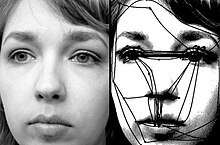
Back حركة العين الرمشية Arabic Moviment sacàdic Catalan Οφθαλμική μεταπήδηση Greek Movimientos sacádicos Spanish حرکت جهشی چشم Persian Saccade oculaire French Sacáidí Irish Szakkád Hungarian Saccade Italian Saccade Dutch
This article needs additional citations for verification. (August 2020) |

A saccade (/səˈkɑːd/ sə-KAHD; French: [sakad]; French for 'jerk') is a quick, simultaneous movement of both eyes between two or more phases of fixation in the same direction.[1] In contrast, in smooth-pursuit movements, the eyes move smoothly instead of in jumps. The phenomenon can be associated with a shift in frequency of an emitted signal[clarification needed] or a movement of a body part or device.[2] Controlled cortically by the frontal eye fields (FEF), or subcortically by the superior colliculus, saccades serve as a mechanism for fixation, rapid eye movement, and the fast phase of optokinetic nystagmus.[1] The word appears to have been coined in the 1880s by French ophthalmologist Émile Javal, who used a mirror on one side of a page to observe eye movement in silent reading, and found that it involves a succession of discontinuous individual movements.[3]
- ^ a b Cassin, B. and Solomon, S. Dictionary of Eye Terminology. Gainesville, Florida: Triad Publishing Company, 1990.[page needed][ISBN missing]
- ^ Gegenfurtner, K. R. (2016). "The interaction between vision and eye movements". Perception. 45 (12): 1333–1357. doi:10.1177/0301006616657097. PMID 27383394.
- ^ Javal, É (1878). "Essai sur la physiologie de la lecture". Annales d'Oculistique (in French). 80: 61–73.
© MMXXIII Rich X Search. We shall prevail. All rights reserved. Rich X Search